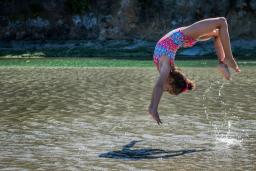Balance Beam Basics: Tips and Techniques for Young Gymnasts
 Balance beam Coaching
Balance beam Coaching
Understanding the Balance Beam
Before your child takes their first steps on the beam, it's crucial to understand what it entails. The balance beam, elevated about four feet off the ground, is a narrow platform where gymnasts perform a mix of jumps, turns, and acrobatic moves. It's not just about physical skills; mental focus and confidence are key.
Finding the right Gymnastic Class is essential. Look for Gymnastic Schools or coaches who emphasize safety, fun, and age-appropriate development. Classes should be tailored to children's needs, ensuring they learn at their own pace.
Safety First: Equipment and Environment : Safety can't be overstressed. Ensure the Gymnastic Schools or clubs you choose have well-maintained equipment and a safe environment. Mats should surround the beam to cushion any falls.
Building Confidence: One Step at a Time :The balance beam can be intimidating. Start with the basics on a low beam or even a line on the floor. Encourage your child to walk forwards, backwards, and sideways. Gradual progression builds confidence.
Developing Balance and Coordination :Balance and coordination are fundamental. Practice exercises off the beam, like standing on one leg or walking along a taped line. These activities can be fun and done at home, making it a part of your child's daily play.
Strength and Flexibility: The Cornerstones of Beam Success :A strong core and good flexibility are vital for beam routines. Incorporate exercises like planks, sit-ups, and stretches into your child’s routine. Gymnastic Coaches can provide specific exercises for this purpose.
The Mental Game: Focus and Determination :Gymnastics is as much mental as it is physical. Teach your child to visualize their routine and approach the beam with a positive mindset. Mistakes are part of learning – encourage them to get up and try again.
The Role of Parents and Carers :Your role is crucial. Be supportive, celebrate small victories, and understand that progress takes time. Avoid pressuring your child; instead, focus on the fun and the journey.
Finding the Right Coach :A good coach can make all the difference. Look for qualified Gymnastic Coaches who are experienced with kids and can provide constructive, positive feedback.
Competitions: Preparing for the Big Day :If your child decides to compete, preparation is key. Attend competitions to familiarize them with the environment. Encourage them to practice their routine, but also remind them that competing is about personal bests and having fun.
Celebrating Every Step :Every child's gymnastics journey is unique. Celebrate each milestone, whether it’s mastering a new skill or simply gaining more confidence. The balance beam, with its challenges and triumphs, is a fantastic way for kids to grow, not just as gymnasts, but as confident and resilient individuals.
FAQ Section
- Q: At what age can my child start learning the balance beam?
A: Kids can start basic beam skills at a young age, often around 4-5 years old, in a safe and supervised environment. - Q: How often should my child practice?
A: Consistency is key. A few times a week under supervision is a good start, but this depends on the child’s age, skill level, and interest. - Q: What should my child wear for beam practice?
A: Comfortable, form-fitting clothing is best. Gymnastics leotards are ideal as they allow freedom of movement and coaches can easily spot body alignment.

